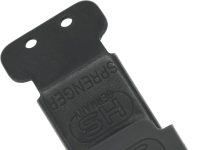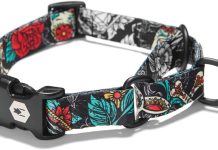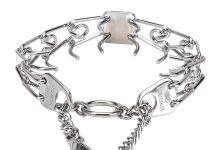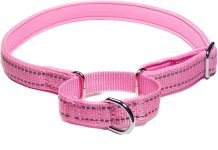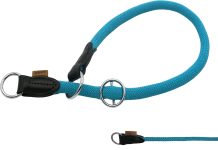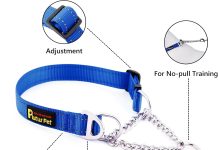In our article, we explore the question of whether bark collars are safe for all dog breeds. Many dog owners have turned to these collars as a potential solution to excessive barking, but concerns have arisen about their effectiveness and their impact on different breeds. We delve into the topic, examining the potential risks and benefits associated with bark collars and shedding light on whether they are truly a safe and humane option for all dogs.
What Are Bark Collars?
Bark collars are a type of training tool designed to reduce or eliminate excessive barking in dogs. They typically consist of a collar that can be secured around the dog’s neck and are equipped with various mechanisms, such as vibration, sound, or static pulse stimulation, that are triggered by the dog’s barking behavior.
Table of Contents
Definition
Bark collars provide a corrective stimulus when a dog barks excessively, aiming to deter the behavior and promote quietness. These collars work by detecting the vocalizations of the dog and delivering a response, such as a mild shock or a high-pitched sound, that is intended to interrupt the barking pattern.
Types of Bark Collars
There are several different types of bark collars available on the market, each utilizing different techniques to deter excessive barking. Some common types include:
-
Static Bark Collars: These collars deliver a mild static shock to the dog’s neck when it barks, similar to a static electricity shock. The intensity of the shock can often be adjusted to suit the sensitivity of the dog.
-
Vibration Bark Collars: Instead of using a shock, these collars vibrate when the dog barks, providing a distraction that can interrupt the barking behavior.
-
Sound Bark Collars: These collars emit a high-pitched sound, usually inaudible to humans but uncomfortable for dogs, whenever the dog barks excessively.
-
Spray Bark Collars: These collars release a burst of citronella-scented spray or an unscented spray when the dog barks. The unpleasant scent or sensation deters the dog from continuing to bark.
Potential Risks of Using Bark Collars
While bark collars can be effective in reducing excessive barking, it is important to consider the potential risks associated with their use.
Physical Discomfort and Injury
One of the primary concerns with bark collars is the potential for physical discomfort or injury to the dog. The use of static shock collars, for example, can cause pain, burn marks, or skin irritation if not used properly or on dogs with sensitive skin. It is essential to ensure that the collar is fitted correctly, so it does not cause any harm to the dog.
Psychological Effects
Bark collars that utilize aversive stimuli, such as shock or spray, may have psychological effects on dogs. Some dogs may become anxious, fearful, or even aggressive if they associate the aversive stimulus with certain situations or people. It is crucial to monitor the dog’s behavior closely and discontinue the use of the collar if any negative psychological effects are observed.
Negative Association with People or Places
If a dog consistently receives an aversive stimulus, such as a shock or spray, when barking, it may develop a negative association with certain people or places. This can result in fear or anxiety in the presence of specific individuals or in particular environments, potentially leading to behavioral issues.
Factors Affecting the Safety of Bark Collars
Several factors contribute to the safety of bark collars, including the dog’s size and breed, temperament and sensitivity, and any existing health conditions.
Dog’s Size and Breed
The size and breed of the dog play a crucial role in determining the suitability and safety of a bark collar. Smaller dogs may be more sensitive to the aversive stimuli and require lower intensities, while larger breeds may have a higher pain threshold and may need a stronger stimulus for it to be effective.
Temperament and Sensitivity
The temperament and sensitivity of the dog are also important considerations. Some dogs may be naturally more sensitive or easily frightened, while others may be more resilient or less reactive to stimulation. It is essential to assess the individual dog’s temperament and sensitivity level before using a bark collar.
Health Conditions
Certain health conditions may impact the safety of using a bark collar. Dogs with pre-existing skin issues or allergies may be more prone to adverse reactions from collars that utilize static shocks or sprays. It is crucial to consult with a veterinarian if the dog has any underlying health conditions before using a bark collar.
Safe Usage Guidelines for Bark Collars
To ensure the safe and effective use of bark collars, there are some essential guidelines to follow.
Appropriate Collar Fit
Proper fitting of the bark collar is vital to prevent discomfort or injury to the dog. The collar should fit snugly around the dog’s neck without being too tight or too loose. It is recommended to follow the manufacturer’s instructions on how to measure and fit the collar correctly.
Correct Collar Settings
The intensity level or deterrent mechanism used by the bark collar should be set at the appropriate level for the individual dog. It is essential to start with the lowest setting and gradually increase if necessary, while closely monitoring the dog’s response. Careful observation and adjustment of the collar settings will help ensure the dog’s safety and comfort.
Regular Monitoring and Supervision
It is crucial to closely monitor the dog when using a bark collar and never leave the collar on the dog unattended for extended periods. Regularly check the dog’s skin for any signs of irritation or discomfort and be attentive to any changes in the dog’s behavior or temperament.
Breed Differences and Their Impact on Bark Collar Safety
Different dog breeds may have varying responses to bark collar training due to their unique traits and characteristics. Here are some breed-specific considerations regarding the safety of using bark collars:
Toy and Small Breeds
Toy and small breeds, such as Chihuahuas or Shih Tzus, are often more delicate and sensitive. It is crucial to use minimal intensities on bark collars for these breeds and carefully monitor their reactions to avoid any potential harm or distress.
Medium and Large Breeds
Medium and large breeds, like Labrador Retrievers or Golden Retrievers, may require higher intensities or stronger stimuli to be effective. However, it is still essential to ensure that the collar is used safely and not set at excessively high levels that may cause harm.
Working and Sporting Breeds
Working and sporting breeds, such as Border Collies or German Shepherds, are generally highly energetic and driven. These breeds may require more extensive training, including positive reinforcement techniques, in addition to bark collar usage, to achieve desired results safely and effectively.
Guarding Breeds
Guarding breeds, such as Doberman Pinschers or Rottweilers, often have a strong protective instinct. They may have a more intense reaction to the aversive stimuli used in bark collars. It is crucial to carefully assess their temperament and use the collar under professional guidance.
Herding Breeds
Herding breeds, like Australian Shepherds or Border Collies, are known for their high intelligence and sensitivity. These breeds may require a gentle approach with bark collar usage to avoid triggering anxiety or fear-based behaviors.
Scent Hound Breeds
Scent hound breeds, such as Beagles or Bloodhounds, have a strong instinct to vocalize when they detect scents or when they are on the trail. While bark collars can be beneficial for reducing excessive barking, it is essential to consider the breed’s natural tendencies and use the collar appropriately.
Terrier Breeds
Terrier breeds, like Jack Russell Terriers or Yorkshire Terriers, are often feisty and independent. They may require a combination of positive reinforcement training and bark collar usage to address excessive barking effectively and safely.
Sighthound Breeds
Sighthound breeds, such as Greyhounds or Whippets, are known for their speed and agility. These breeds may have a higher pain tolerance due to their hunting instincts, but it is still important to use the collar safely and carefully monitor their responses.
Companion Breeds
Companion breeds, like Poodles or Bichon Frises, are typically bred for their calm and affectionate nature. These breeds may be more sensitive to the aversive stimuli used in bark collars, requiring lower intensities to achieve the desired results safely.
Mixed Breeds
Mixed breed dogs can vary greatly in their traits and sensitivities, depending on their genetic background. It is crucial to consider the individual dog’s characteristics and potential breed influences when determining the safety and suitability of using a bark collar.
Expert Opinions on Bark Collars for Different Breeds
To gain a comprehensive understanding of the safety of bark collars for different breeds, it is essential to consider the opinions of experts in the field, such as veterinarians, dog trainers, and behaviorists.
Veterinarians
Veterinarians often have valuable insights into the physiological and behavioral aspects of different breeds. While opinions may vary, some veterinarians may recommend alternative methods, such as positive reinforcement training, over bark collars due to the potential risks associated with their use.
Dog Trainers
Experienced dog trainers can provide guidance on the safe and effective use of bark collars. They can assess the individual dog’s training needs and help develop a comprehensive training plan that incorporates the use of bark collars, if deemed suitable and necessary.
Behaviorists
Behaviorists specialize in understanding and modifying canine behavior. They can provide valuable insights into the underlying reasons behind excessive barking and offer alternative strategies to manage and address the behavior without relying solely on bark collar training.
Alternatives to Bark Collars
For dog owners who prefer to explore alternative options to bark collars, there are various methods and techniques available.
Positive Reinforcement Training
Positive reinforcement training techniques, such as rewarding desired behaviors and ignoring or redirecting unwanted behaviors, can help address excessive barking. This approach focuses on rewarding the dog for being quiet rather than punishing for barking.
Behavioral Modification Techniques
Behavioral modification techniques, including desensitization and counterconditioning, can be effective in reducing excessive barking by gradually exposing the dog to stimuli that trigger barking and teaching it alternative, more acceptable behaviors.
Dog Appeasing Pheromones
Dog appeasing pheromones, available in diffuser or collar form, emit a synthetic replica of the pheromone produced by mother dogs to calm their puppies. These pheromones can help reduce anxiety and stress-related barking in certain dogs.
Ultrasonic Devices
Ultrasonic devices emit high-pitched sounds that are unpleasant to dogs but inaudible to humans. These devices can be used to interrupt barking patterns and redirect the dog’s attention without the need for aversive stimuli.
Selecting the Right Collar for Your Dog
When considering purchasing a bark collar, it is crucial to choose the right collar that suits the needs and characteristics of your dog.
Considerations Before Purchase
Before purchasing a bark collar, consider factors such as your dog’s size, breed, temperament, and specific barking patterns. Consult with professionals, such as veterinarians or dog trainers, to determine whether a bark collar is an appropriate training tool for your dog.
Collar Features to Look for
When selecting a bark collar, look for adjustable intensity levels, multiple stimulus options (such as vibration or sound), and a comfortable and safe design. Read product descriptions and customer reviews to ensure that the collar meets your dog’s specific needs.
Customer Reviews and Recommendations
Reading customer reviews and seeking recommendations from other dog owners can provide valuable insights into the effectiveness and safety of different bark collar brands and models. Consider the experiences of others, but remember that each dog’s response to bark collars may vary.
The Importance of Professional Guidance
Seeking professional guidance is crucial when deciding to use a bark collar for your dog.
Consulting a Veterinarian
Before using a bark collar, consult with a veterinarian who is familiar with your dog’s health history. They can assess any potential risks or suitability issues and provide personalized recommendations based on your dog’s individual needs.
Seeking Advice from Qualified Dog Trainers
Qualified dog trainers can provide expert guidance on training techniques and help determine whether a bark collar is appropriate for your dog’s specific behavior and training goals. They can also provide ongoing support and advice throughout the training process.
Considering Individual Dog’s Needs
Every dog is unique, and what works for one dog may not work for another. Take into account your dog’s personality, temperament, and individual needs when deciding to use a bark collar. Be open to adjusting training methods or considering alternative approaches if necessary.
Conclusion
Bark collars can be effective tools for reducing excessive barking in dogs, but their safety and suitability depend on various factors, including the dog’s size, breed, temperament, and health conditions. It is essential to use bark collars responsibly by following safe usage guidelines, consulting professionals, and considering alternative training methods when necessary. Ultimately, the goal should be to establish effective communication and trust with your dog while promoting a happy and healthy canine-human relationship.


